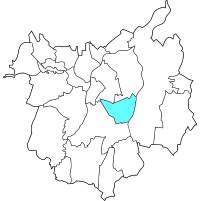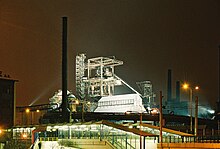Vítkovice (Ostrava)
| Vítkovice | ||||
|---|---|---|---|---|
|
||||
| Basic data | ||||
| State : |
|
|||
| Region : | Moravskoslezský kraj | |||
| District : | Ostrava-město | |||
| Municipality of: | Ostrava | |||
| Area : | 648 ha | |||
| Geographic location : | 49 ° 48 ' N , 18 ° 16' E | |||
| Height: | 229 m nm | |||
| Residents : | 7,413 (January 1, 2008) | |||
| Postal code : | 703 00 | |||
| License plate : | T | |||
| traffic | ||||
| Street: | Frýdek-Místek - Hlučín | |||
| Railway connection: |
Ostrava hl.n. - Frýdlant nad Ostravicí Český Těšín – Polanka nad Odrou |
|||
| Next international airport : | Ostrava Airport | |||
| structure | ||||
| Status: | Borough | |||
| Districts: | 1 | |||
| administration | ||||
| Mayor : | Petr Dlabal | |||
| Address: | Mírové náměstí 1 703 79 Ostrava-Vítkovice |
|||
| Website : | www.vitkovice.ostrava.cz | |||
Vítkovice (German Witkowitz ) is a district of the statutory city of Ostrava in the Czech Republic . It is located three kilometers south of the city center.
geography
Vítkovice is to the left of the Ostravice in the Ostrava basin. State road 56 from Frýdek-Místek to Hlučín and 11 from Opava to Šenov run through the district .
Neighboring districts are Moravská Ostrava (Mährisch Ostrau) and Slezská Ostrava (Silesian Ostrava) in the north, Radvanice in the northeast, Kunčičky and Kunčice in the east, Hrabůvka in the southeast, Dubina in the south, Bělský Les in the southwest, Zábřeh in the west and Hulváky in the northwest.
No districts are shown for the Vítkovice district. It consists of the cadastral districts of Vítkovice and Zábřeh-VŽ.
history
Vítkovice was first mentioned in writing as Witchendorff in 1357 , when the brothers Peter and Johann von Paskov confirmed the inheritance jurisdiction of their cousin Michael. The name of the place probably comes from Witek von Wigstein, who was enfeoffed with the episcopal castle Schauenstein in 1369 . At the beginning of the 15th century the village came under the rule of Hochwald and was mortgaged with this by Emperor Sigismund to Nikolaus Sokol von Lamberg. In 1581 the village consisted of 12 properties and had between 80 and 100 inhabitants. By 1772 the number of residents had grown to 233. Witkowitz remained a farming village until the first third of the 19th century.
industrialization
In 1828 the Archbishop of Olomouc, Rudolf Rainer, had an ironworks built north of the village , which was the first in the kk monarchy to work using the puddle method. After the bishop's death three years later, Salomon Rothschild endeavored to acquire the modern and profitable Rudolfshütte from the cathedral chapter , which belonged to the archbishopric iron works in Friedland , which he succeeded in 1843. In the meantime, the operator consortium had the plant expanded to include a coke oven in 1836 and a rolling mill three years later . In 1843 Witkowitz had 328 inhabitants.
From 1850 Witkowitz formed a municipality in the Mistek district . Rothschild, who also financed the construction of the Kaiser-Ferdinand-Nordbahn , had a connecting line built from the Mährisch Ostrau station in Privoz to his Witkowitz ironworks and the Caroline mine , which was completed in 1855. The Kaiser-Ferdinands-Nordbahn bought the mine railway and extended it to Michalkowitz in 1862 and to Dombrowa and Orlau in 1870 . The Neu Witkowitz workers' settlement emerged under the Rothschilds . Founded in 1873, the Witkowitz Mining and Metallurgy Union was the largest steelworks in the Habsburg monarchy. Tenement houses and colonies were built for the ironworkers . The place grew rapidly and the workers came not only from Moravia and Austrian Silesia, but also immigrated from the German Empire, Russian Poland and especially as cheap workers from Galicia . In 1880 Witkowitz had a share of 57% of the iron production in Moravia and Austrian Silesia . In 1885 the metal works Dingo-Dienenstahl and the cement factory of Adolf Suesse & Comp. founded. The church was built in 1888 and a little later a synagogue was built . In 1891 the Louis coal mine opened in Witkowitz . Subsequently, other smaller companies settled. In 1902 a town hall was built and the industrial community received an urban infrastructure.
In 1900 the municipality had an area of 436 hectares, 511 buildings with 19123 inhabitants (4386 people / km²), of which 7898 (41.3%) were German-speaking, 7677 (40.1%) Czech-speaking and 2519 (13.2%) others Language - mainly Polish-speaking; 17755 (92.8% of the total local population) were Catholics, 646 (3.4%) Protestants, 716 (3.7%) Jews, 6 other faiths.
Early 20th century
On December 11, 1908, Witkowitz was raised to town by Emperor Franz Joseph I. In 1910 there were over 23,000 people in the city. That number rose to 27,359 by 1921. Around 22,200 people were employed in the town's iron and steel works and machine works at that time. In 1924 Witkowitz / Vitkovice was incorporated into Mährisch Ostrau as part of the plans to create a "Groß Ostrau".
After 1945 to 1990
After the Second World War, the building fabric in Vítkovice was severely neglected and at the end of the 1960s, a partial demolition of the dilapidated Wilhelminian-style houses began in order to expand the steelworks. The Witkowitz Mining and Steelworks Union was nationalized in 1948 and renamed "Klement-Gottwald-Eisenwerke" in the 1950s after the deceased President Klement Gottwald . In the 1970s, the construction of a large prefabricated housing estate on the green meadow to the west to Zábřeh began.
Since 1990
After the Velvet Revolution , the restoration of the old buildings in Vítkovice and the preservation of industrial monuments began in 1989. In 1990 the Vítkovice district was established. In 1991 the place had 7,292 inhabitants. In 2001 Vítkovice consisted of 708 houses in which 7518 people lived.
economy
Established businesses:
- JC TRANS, sro - freight and passenger transport
- Škoda Vagonka
- Vítkovice Steel as
- Vítkovice Machinery Group
- Hutní montáže as
Sports
The ČEZ Aréna is located on the border with Zábřeh . It is the home of the HC Vítkovice Steel ice hockey club, founded in 1928 . The football club FC Vítkovice has been based in the city since 1919 .
sons and daughters of the town
- Viktor von Scheuchenstuel (1857–1938), General
- Eduard Pant (1887–1938), journalist and politician
- Karl Brand (1895–1917), poet
- Alexander Sacher-Masoch (1901–1972), Austrian writer
- Ilse Weber (1903–1944), Czech writer
- Leopold Ludwig (1908–1979), German Kapellmeister
- Josef Schwarz (1910–1985), German politician
- Beno Blachut (1913–1985), Czech tenor
- Miroslav Klega (1926–1993), Czech composer
- Peter Burian (* 1931), historian
- Walter Josef Lorenz (* 1932), German biophysicist
Attractions
- Witkowitz iron works , the blast furnace and the iron foundry-coking plant were declared a national cultural monument in 2002
- Vitkovice Castle, built 1846–1847 for Salomon Rothschild , today owned by Vítkovice Holding as
- neo-Gothic parish church of St. Paul, built in 1888
- Site of the Yeremenko colliery, formerly Louis colliery, technical monument
- Town hall, built in 1902
Web links
Individual evidence
- ↑ Hošák, Ladislav - Šrámek, Rudolf: Místní jména na Moravě a ve Slezsku I-II. Prague
- ^ Community encyclopedia of the kingdoms and countries represented in the Imperial Council, edited on the basis of the results of the census of December 31, 1900, X. Moravia . Vienna: 1906.




